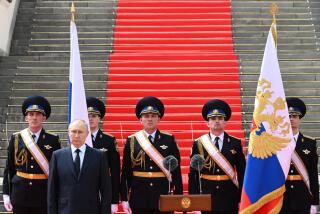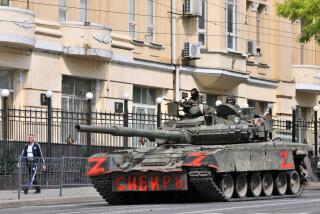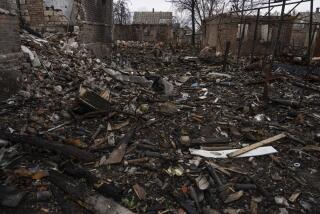A PEOPLE’S TRAGEDY: A History of the Russian Revolution, 1891-1924.<i> By Orlando Figes</i> . <i> Viking: 923 pp., $39.95</i>
- Share via
I
Not so long ago, popular presentations of the Russian Revolution, even in “capitalist” countries, were cast in the heroic mode, a view that descended from John Reed’s “Ten Days That Shook the World” and Sergei Eisenstein’s “October” to Warren Beatty’s “Reds.” And on a more scholarly level, professional Sovietology told a story of solid Communist achievement: 1917 was a genuine workers’ revolution and the resulting Soviet regime, though, fallen into grievous sin under Stalin, had nonetheless created a viable “modern” society, a perspective that emerged in the 1970s in reaction against the “Cold War” thesis of Soviet “totalitarianism” and which during Gorbachev’s perestroika was prominent on the “McNeil-Lehrer News Hour.” This “revisionism,” moreover, purported to speak the language of “value-free” social science and grounded its explanations not in the surface phenomena of party politics or of Soviet ideology but in the deeper processes of social history.
With communism’s fall between 1989 and 1991, this optimistic social science perspective was irreparably compromised. For it turned out that the Soviet system had never been “modern” after all, but only a primitive means of sweating a servile population to furnish the wherewithal for an imitation superpower. The time has therefore come for the revision of revisionism. So the October Revolution is now seen as the origin of a disaster, and 20th century Russia is increasingly presented in the tragic mode. Orlando Figes’ “A People’s Tragedy” is a key item in this much-needed revision of revisionism.
His book, however, is still focused on social process: As the author declares a bit militantly, “We are all social historians now.” Fortunately, this is not entirely true--as will later be made clear by a discussion of Marxism’s crucial role in the revolution. For the moment, suffice it to express satisfaction that his social history is hardly that of his predecessors. Indeed, he has stood their approach quite on its head.
For a start, his book wears its social science lightly, indeed often employing procedures more usually found in a novel or a Ken Burns television documentary. Diaries and letters of representative social types are interwoven with the political narrative leading from the old regime to the new; by the end, we know each figure as a personality. Thus Prince George Lvov, leader of his zemstvo (elected local administration), briefly applied his liberal principles as head of the provisional government of 1917 only to wind up with the Whites and to die an emigre in Paris. Another squire, Gen. Alexis Brusilov, was moved by Russian patriotism to serve first the czar, then the provisional government and, finally, the Red Army. The proletarian writer and humanitarian intellectual Maxim Gorky had a love-hate relationship with Lenin under the old regime and an equally ambivalent attitude toward the new regime that Bolshevism had built and so, wound up its prisoner under Stalin.
On a lower social level, we follow the peasant Semen Kanatchikov from the village to the factory, to Marxism and Bolshevism, and then to a career as a middling Soviet cultural apparatchik. On a parallel track is another literate peasant, Dimitry Os’kin, who was freed from the village by service as a noncom during World War I and who moved up to Red commander during the civil war and ended up a Soviet military bureaucrat. Very different is another peasant, however: the Tolstoyan Sergei Semenov, who struggled to wrest his village from its hidebound elders and thus welcomed Prime Minister Petr Stolypin’s program of 1908 for dissolving the rural commune; his dreams were fulfilled when the revolution gave the peasants all the land, but the old order had its revenge when the kulak elders murdered him in 1922. And Figes passes up no occasion to illustrate the brutality, squalor and mayhem of Russian peasant life.
It is with his analyses of rural Russia that Figes really stands the erstwhile revisionists on their heads. The old social history was the upbeat history of the working class moving toward self-awareness and an October liberation. Figes’ social history is decidedly downbeat and focuses on the peasantry moving toward vengeful revolt ending in Bolshevik tyranny. The workers, of course, are present in this story, but they are hardly the motive force of the revolution. Nor are they very different sociologically and psychologically from the peasantry out of which they came. Figes dismisses the once-passionate debate over whether the revolution was made by class-conscious proletarians or by raw rural recruits to the factory by saying that the autocracy made both groups revolutionary.
This all-encompassing revolt of the Russian masses, moreover, is presented as destructive and degrading more than as creative and liberating, the product of the peasantry’s resentments, hatreds and aspirations for power. Figes’ Russian Revolution thus turns out to be the tragedy of a people produced by that people. Indeed, he offers one of the bleakest pictures of Mother Russia since Tolstoy’s “The Power of Darkness.”
II
Figes’ peasant revolution begins appropriately with the great famine of 1891. This disaster awakened the social conscience of the educated upper classes, who then exerted pressure on the autocracy to accede to a constitutional regime responsive to society’s needs. This pressure, centering in the zemstvos and fueled after the turn of the century by outbursts of peasant unrest and student militancy, led by 1905 to open revolution against the autocracy. The October general strike of that year forced the autocracy to grant a legislative Duma. This victory was followed, however, by the failure in 1906-07 of the dominant opposition party, the Constitutional Democrats--or Kadets--to compel the monarchy to accept the Duma as a coequal power; that is, to accept a genuine constitution.
Figes attributes the revolution’s failure, first of all, to Nicholas’ inflexibility and a justification by a mystique of divinely ordained autocracy. (He makes too much, however, of the monarchy’s rhetoric of “Muscovite patrimonialism,” when a more likely motive was European absolutism’s traditional fear of a “deluge” if concessions were made.) The consequence of this inflexibility was that the Kadets could never trust the monarchy sufficiently to accept seats in the cabinet, the only arrangement that might have stabilized the new Duma order. Equally responsible for the revolution’s failure, though, was the weakness of Russian “civil society,” the liberal Kadets’ natural base, vis-a-vis the enormous mass of the peasantry, whose continued unrest by 1906 made the squires conservative. The overall result of 1905, therefore, was to use up the liberals’ political credit before the next act of the revolution in 1917. For the failure of the Kadets’ Duma to ease the peasants’ lot, or to create a genuine rule of law that would benefit workers, left the public sphere vacant for occupation by the revolutionary parties.
What turned that sphere over to them completely, however, was World War I. Peasant Russia was mobilized by the millions to fight and die in it, only to have it disastrously mismanaged and to see Russia headed for defeat. The cause was the czar’s continued unwillingness to share power, a policy that became suicidal, and the Duma’s paralysis for fear of unleashing “the Russian riot, mindless and pitiless,” in Pushkin’s famous phrase. So in February 1917, hunger, cold and war weariness unexpectedly brought the monarchy down and confronted the Duma liberals, now organized as a provisional government, with the power of “the street” in the form of a council, or “soviet,” of soldiers and workers’ deputies led by socialist intellectuals.
This “dual power” by its very nature could not last because it reflected the intense antagonism, indeed the veritable hatred, between the nizv (the lower ones) and the verkhi (the higher ones), the “democracy” and the burzhouis (a deformation of bourgeois). This antagonism, for Figes, was broader than the Marxist dichotomy of proletarians and capitalists, though it was often expressed in that recently acquired ideological vocabulary. For it was built into the structure of traditional lord-peasant Russia and its transposition into the officer-soldier polarity of the old Imperial Army, as well as in the manager-worker stratification of the newer factories. During 1917, all these hierarchies collapsed simultaneously to yield a universal social war.
III
Lenin and his Bolsheviks moved into this volatile situation after April. The party at the time was not the monolithic, structured affair, obedient to the leader’s command, that it later became, but a fluid, restless mass movement. Nor did Lenin have a precise plan leading to his eventual October coup. He desired power, to be sure, but the actual seizure of power was a gamble decided only when he saw that he could get away with it without serious opposition. Figes wastes no time pondering the tired question of whether October was a coup d’etat or a social revolution. He takes the common-sense position that it was both: a coup carried out against a background of social revolution, or more exactly of headlong social disintegration, that ended ingloriously in a two-month binge as the victorious masses looted the Winter Palace’s wine cellar of its tens of thousands of bottles.
As Figes admirably sums up the dynamic governing the Bolsheviks’ seizure of power in October and the building of their new regime in 1918:
“There was of course no master plan to this--everything was improvised, as it had to be in a revolution--yet Lenin, at least, had an instinctive sense of the general direction, of what he himself called the ‘revolutionary dialectic,’ and in many ways that was the essence of his political genius. Local Soviet rule in the countryside, which was in effect the unfettered power of the village assembly to rule itself and divide the gentry’s land, would undermine the need for the [democratically elected] Constituent Assembly in the minds of the peasants and thus destroy the political base of the SRs [peasant-oriented socialists]. The exercise of ‘workers’ control’ through the factory committee would help to dismantle the old industrial infrastructure--what the Bolsheviks called the ‘capitalist system’--while shifting the blame for the industrial crises to the workers themselves [thus justifying party control]. The spread of soldiers’ power and of local peace initiatives at the front, which the Bolsheviks encouraged, would undermine the plans of the old army commanders to mobilize the troops against the new regime and restart the war. Eighty years earlier, the anarchist Michael Bakunin, drawing directly on Hegel, had put the same ‘revolutionary dialectic’ in an aphorism: ‘The desire to destroy is also a creative desire.’ ”
Figes next shows how in the civil war with the Whites between 1918 and 1920, the Bolsheviks’ destructive anarchism gave way to the “creative” dictatorial centralization of their new Soviet state. Volunteer Red Guards were replaced by a regular army commanded by former Imperial officers, yet monitored by party commissars. Factory committees were replaced by single managers and bourgeois specialists, both monitored by the party. Soon all industry and commerce were nationalized and placed under the Supreme Economic Council, the market was suppressed (insofar as possible) in favor of state allocation and distribution and money was slated for abolition.
The regime had begun this process of etatisation by declaring a “grain war” to extract food from the peasants to feed the industrial cities and the Red Army. This war was first conducted as a “class struggle in the villages,” pitting the poor peasants against the “kulak bourgeoisie”; when this failed, war on the “food front” was conducted by armed requisition. Since the “proletarian” party was beset on all sides by “class enemies,” its political police, the Cheka, was given free reign. And once the civil war had been won in 1920, the party proceeded with the “militarization of labor” to rebuild the economy and, indeed, to furnish the definitive form of the new society.
Whence came the ferocious will to build this awesome dictatorship? Figes has a novel and ingenious social explanation: After October, the Bolsheviks’ base was the collapsing industrial cities of Russia’s northern half, a naturally poor region incapable of feeding itself. With the disintegration of the national economy, the southern peasants no longer had an incentive to trade with the northern cities, hence the grain war and loss of peasant support for the regime. The Bolsheviks, moreover, were obsessed with the memory of the Paris Commune, which perished because of the hostility of rural France. Determined to avoid the same fate, they organized a universal military dictatorship to combat both worker spontaneity and peasant anarchy by planned control of the industrial and agricultural economy.
And the party derived the energy for this Herculean task from the fact that its membership--around 700,000 (although Figes tends to inflate party figures throughout) by the end of the civil war--was dominated by upwardly mobile peasants who detested the Russia of “icons and cockroaches” precisely because they had just escaped from it. Their cursus honorum was elementary schooling in the educational boom on the eve of war, service as noncoms during the war and combat as party commissars during the civil war. It is this plebeian and militant phalanx that produced the institutions of War Communism, and it is their ethos that would later animate Stalin’s virulently anti-peasant collectivization and “building of socialism” in the 1930s. For to them, the city and its factories meant progress, enlightenment and civilization.
IV
All of this is quite true as far as it goes, and it has never been put so clearly and cogently. But it does not go far enough, for Figes, with his single-minded focus on social history, largely leaves out the role of the party chiefs, who were making the key decisions and who were neither workers nor peasants but the intelligentsia. True, Figes gives an excellent portrait of their leader, Lenin, or at least Lenin in action: his total obsession with politics, the “rage” (his wife’s phrase) with which he approached every political combat and his utter ruthlessness. Even so, Figes, like so many commentators before him, trivializes Lenin’s motivation by seeing it only as “a burning ambition for power.”
Yet Figes belies his own judgment by the account of the intoxication with which War Communism unfolded. For this account makes clear that Lenin’s “ambition” was not for himself--it was for the transcendent Cause of Socialism. He and the party leaders were not mobilizing to defend their northern industrial bastion as a mere matter of power, and their scorn for the backward village was not a phobia they acquired from their newly recruited peasant base. They obviously derived their obsession with the Paris Commune and their hatred of the “idiocy of rural life” from the grand European Socialist tradition and its chief prophet, Marx. This ideological source is apparent, first, in their endless invocations of “class warfare” against “capitalist kulaks,” “international imperialism” and sundry other “enemies” of “the revolution.” It is apparent also in their ceaseless inveighing against the hydra of the market, engendered “continuously, daily, hourly, spontaneously and on a mass scale” out of private peasant production.
But the Bolsheviks’ ideological inspiration is apparent above all in the fact that the program of War Communism is quite precisely Marx’s own, that is, the abolition of private property, the market and money, or what he called in “Capital,” the extinction of “commodity production for exchange” and what he called in the “Critique of the Gotha Program,” “communism” as the second, highest stage of “socialism.” That this millenarian goal was in fact Marx’s program must be insisted on, since under the combined influence of post-1918 Western social democracy and the alleged “Bukharin alternative” of market socialism in Soviet Russia, this unpleasant fact is now largely forgotten.
But it was hardly ignored at the time. Communism, in Marx’s sense, was the word the party used for its policy during the civil war. The resentments of former peasants would not have been half so ferocious without party legitimation as the world-historical force of “class struggle,” and their bruising, but ultimately trivial, experience of the market would never have yielded, as Figes claims it did, the comprehensive program of War Communism. As Lenin constantly reiterated, “There can be no revolution without theory,” and the Marxist vision of communism as the “end of prehistory” offered just such a theory--as he, Trotsky, Bukharin and other party leaders explained in numerous books at the time. Figes would have been well-advised to omit a diary extract or two for some excerpts from Lenin’s “State and Revolution” or, especially, Bukharin’s messianic “The ABCs of Communism,” which remained the most influential statement of the Party’s aims to the end of the 1920s.
Moreover, if Figes had paid due attention to the obvious Marxist component of the revolution, he would have avoided the all-too-frequent pitfall of declaring the Bolshevik regime “distinctly Russian . . . a mirror image of the czarist state.” Indeed, he immediately contradicts this proposition by asserting that the revolution was a “vast experiment in social engineering . . . the grandest in the history of mankind,” yet that its “ideals were themselves impossible.” In other words, the communist revolution was by no means distinctly Russian--it was the universal utopian adventure of our century and it ended everywhere in disaster because its aims were in fact utopian.
In sum, Figes has superbly delineated the class “base” of the Russian Revolution, and his book will long remain its best social history. Let it be hoped, however, that one day he will put an appropriate ideological “superstructure” on that very solid base.
More to Read
Sign up for our Book Club newsletter
Get the latest news, events and more from the Los Angeles Times Book Club, and help us get L.A. reading and talking.
You may occasionally receive promotional content from the Los Angeles Times.







